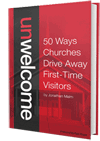Interior signage (sometimes known as “way finding”) feels like the kind of project with the least possible return on the highest possible investment. It is costly, takes time and once installed you forget it’s there.
Yet interior signs are such an important link in the chain to help people get to where they need to go with ease in your church.
I want to share how we managed the design and production process for our interior signs at Crossway Church in Melbourne, Australia. I’ve also included what I missed and what I’d do differently if I could do it again. Making mistakes can cost a lot of money and leave you red faced at installation.
1. Research, Research, Research
There are all kinds of signage systems out there on the market for every budget. Finding out what the standard sizes and lighting/power requirements are will help minimize your budget. You might need some exterior signs, so it helps to keep everything in mind.
2. Walk Through Your Facility
Explore your facility as though you are a first time visitor. Find out where the visitors will need to make critical decisions about where they need to go. Write out your navigation ideas.
Invite a friend who isn’t familiar with your facility to walk around with you and see if it makes sense to them. It’s tempting to skip this step, but you can probably walk your facility blindfolded. Get that outside perspective.
3. Talk to Your Stakeholders
People use your church facility for all kinds of reasons. Get agreement on names of rooms and your central point of connection. For example our weekend welcome desk in our church foyer is also our church office reception. Suppliers instinctively go to reception but we called it ‘welcome desk’ for simplicity’s sake. Different visitors are looking for different destinations and you have to make a decision on who has priority.
4. Develop a Brief For Design and Production
Give your map and initial signage ideas to different supplier and ask for their opinion. They may be able to improve on the quality of the project scope. If you do get feedback and ideas for new features you want, be sure to share those with other suppliers so the quotes you’re comparing are covering the same work.
It’s also a good idea to get the suppliers to quote on doing any electrical work. This may be a small component of the project, but it can be costly if overlooked.
Be sure to include a few rounds of design iterations in the initial cost as I found this can change throughout a project.
Factor into your production timeline any local municipal approval for permits for external signage. Your supplier may even be able to assist you with this.
Ideally have your supplier plan to take focus groups through your facility to ensure that your signage is working as intended.
5. Set Preliminary Budget
Because of the large financial cost of signage systems, the longer the lead time the better for future budget planning. If you are able, finalize your quotes before your next financial budget planning season begins.
It’s a good idea to add a 10% contingency to your budget to account for any unforeseen circumstances. If you can count on anything, it’s unforeseen circumstances.
6. Test With External Focus Groups
Once you have a first iteration of the signs done, gather small groups of people together who have never been to the facility before to walk through the facility. This is an excellent way to test and refine your initial own walk through.
7. Walk Through When Doing Final Artwork Approval With Someone Else
As a project moves forward, so do the artwork changes. Stand in the spot where the sign is positioned to check whether the sign is still correct. Have a partner to double check that the sign still makes directional sense and check the spelling.
8. Revise and Forward Plan
Once your system is in place you will undoubtedly get feedback from the different user groups. Build a forward contingency budget to manage any alterations due to errors or changes to your facility (our facility is going under some minor changes and we know that we will soon need to add some additional signage).
Not As Fun, But Vital
Successfully delivering a signage system isn’t as cool as developing a website or creating video for others, but it can be a vital part of your visitor experience and make their first visit that much easier.
Got questions about the process or do you have you do experience developing it for a church? Drop a comment below, I’d love to hear from you.
 More:
More:
- Learn more about how to welcome church visitors with this massive collection of resources and blog posts.
- Walking into a church for the first time can be scary. Check out Unwelcome: 50 Ways Churches Drive Away First-Time Visitors by Jonathan Malm for practical ideas and perspective on first-time guests.





Jim Engstrom
May 20, 2014
Any thoughts on how to find a top notch supplier? I’m in Minnesota, USA, so I understand if you aren’t familiar with our options here.
What about typography for signs? Common mistakes, or thing to avoid? Ability to control tracking & kerning?
Whatever insights you have are appreciated! I am in the extreme preliminary stages of our signage project, and crave thoughtful advice.
Thanks!
Brandon Roberts
May 13, 2015
This website has been a big help to me, because it was exactly what I was looking for. A local pastor wanted to add some new things to our church, and some internal signs was one of them. I like how you talked about testing it with other people once the signs are put in. That was you can see if the signs are affective or not. I will make sure I let him know about this, and all the other tips.